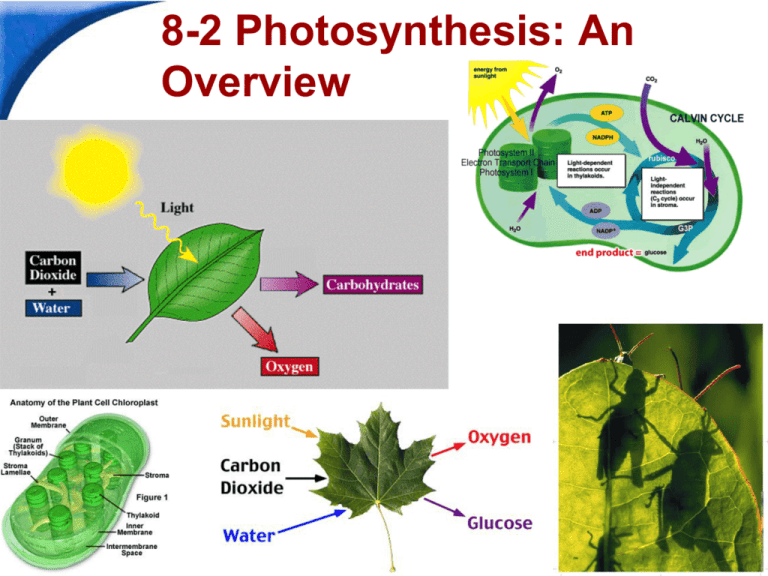
8-2 Photosynthesis: An
Overview
Slide
1 of 28
End Show
8-2 Photosynthesis: An Overview
8-2 Photosynthesis: An
Overview
Photosynthesis is the process in which green
plants use the energy of sunlight to convert water
and carbon dioxide into high-energy carbohydrates
and oxygen.
Slide
2 of 28
End Show
8-2 Photosynthesis: An Overview
The Photosynthesis
Equation
What is the overall equation for
photosynthesis?
Slide
3 of 28
Copyright Pearson Prentice Hall
End Show
8-2 Photosynthesis: An Overview
The Photosynthesis
Equation
The Photosynthesis Equation
The equation for photosynthesis is:
6CO2 + 6H2O
Light
carbon dioxide + water
C6H12O6 + 6O2
Light
sugars + oxygen
Slide
4 of 28
Copyright Pearson Prentice Hall
End Show
8-2 Photosynthesis: An Overview
The Photosynthesis
Equation
Light energy
H2O
Light-Dependent
Reactions
(thylakoids)
ADP
+
NADP
Sugar
O2
ATP
NADPH
Calvin Cycle
(stroma)
Copyright Pearson Prentice Hall
CO2
+
H20
Slide
5 of 28
End Show
8-2 Photosynthesis: An Overview
Light and Pigments
What is the role of light and chlorophyll in
photosynthesis?
Slide
6 of 28
Copyright Pearson Prentice Hall
End Show
8-2 Photosynthesis: An Overview
Light and Pigments
Light and Pigments
How do plants capture the energy of sunlight?
In addition to water and carbon dioxide,
photosynthesis requires light and
chlorophyll.
Slide
7 of 28
Copyright Pearson Prentice Hall
End Show
8-2 Photosynthesis: An Overview
Light and Pigments
Plants gather the sun's energy with light-absorbing
molecules called pigments.
The main pigment in plants is chlorophyll.
There are two main types of chlorophyll:
• chlorophyll a
• chlorophyll b
Slide
8 of 28
Copyright Pearson Prentice Hall
End Show
8-2 Photosynthesis: An Overview
Light and Pigments
Estimated Absorption (%)
Chlorophyll absorbs light well in the blue-violet
and red regions of the visible spectrum.
100
80
60
Chlorophyll b
Chlorophyll a
40
20
0
(nm)
400 450 Wavelength
500 550 600
650 700 750
Wavelength (nm)
Slide
9 of 28
Copyright Pearson Prentice Hall
End Show
8-2 Photosynthesis: An Overview
Light and Pigments
Chlorophyll does not absorb light within the green
region of the spectrum.
Slide
10 of 28
Copyright Pearson Prentice Hall
End Show
8-2 Photosynthesis: An Overview
Light and Pigments
When chlorophyll absorbs light, much of the
energy is transferred directly to electrons in the
chlorophyll molecule.
These high-energy electrons are what make
photosynthesis work.
Slide
11 of 28
Copyright Pearson Prentice Hall
End Show
8-2
Click to Launch:
Continue to:
- or -
Slide
12 of 28
End Show
Copyright Pearson Prentice Hall
8-2
In van Helmont's experiment, most of the added
mass of the tree came from
a. soil and carbon dioxide.
b. water and carbon dioxide.
c. oxygen and carbon dioxide.
d. soil and oxygen.
Slide
13 of 28
End Show
Copyright Pearson Prentice Hall
8-2
Plants use the sugars produced in
photosynthesis to make
a. oxygen.
b. starches.
c. carbon dioxide.
d. protein.
Slide
14 of 28
End Show
Copyright Pearson Prentice Hall
8-2
The raw materials required for plants to carry out
photosynthesis are
a. carbon dioxide and oxygen.
b. oxygen and sugars.
c. carbon dioxide and water.
d. oxygen and water.
Slide
15 of 28
End Show
Copyright Pearson Prentice Hall
8-2
The principal pigment in plants is
a. chloroplast.
b. chlorophyll.
c. carotene.
d. carbohydrate.
Slide
16 of 28
End Show
Copyright Pearson Prentice Hall
8-2
The colors of light that are absorbed by
chlorophylls are
a. green and yellow.
b. green, blue, and violet.
c. blue, violet, and red.
d. red and yellow.
Slide
17 of 28
End Show
Copyright Pearson Prentice Hall
END OF SECTION





